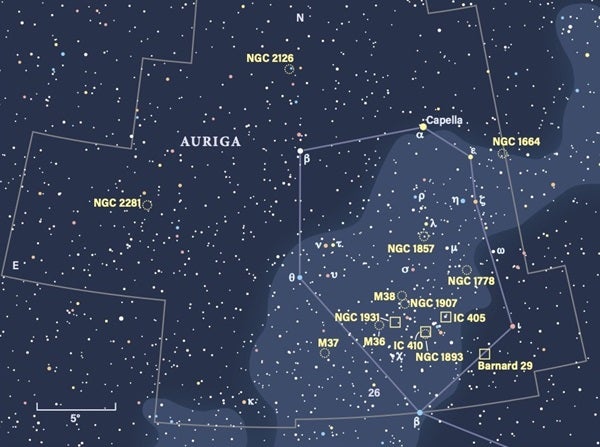Hi folks, tune in every week of 2023 for the best in astronomy from Astronomy Editor Dave Eicher, brought to you by Celestron.
This week, we’ll discuss the great winter targets you can observe in the constellation Auriga the Charioteer.
The constellation Auriga (pronounced or-EYE-guh), a star pattern known by this name for several thousand years, is easy to recognize primarily because of its brightest star, Capella (Alpha [α] Aurigae). This luminary is the sixth-brightest nighttime star and shines with an intense yellow light. The constellation’s Beta star, magnitude 1.9 Menkalinan, is 40th brightest.
The Charioteer is visible in the evening from mid-autumn through winter in the Northern Hemisphere. Its center lies at R.A. 6h01m and Dec. 42° north. Auriga ranks 21st in size out of the 88 constellations, covering 657.44 square degrees (1.59 percent) of the sky. Its size is a bit of a hindrance to its visibility, however. It lies in the middle of the constellation ladder (43rd) in terms of overall brightness.
With respect to visibility, anyone living north of latitude 34° south can see the entire figure at some time during the year. And it’s completely invisible only to those who live at latitudes south of 62° south.
Auriga contains three Messier objects (all open clusters) and several other open clusters and emission nebulae. Because it lies along the Milky Way, it doesn’t contain any galaxies. As you can see, however, lots of targets lie within its borders for you to point a telescope at. Good luck!
For more information on what to look for in the sky each week, visit: https://www.astronomy.com/tags/sky-this-week/
Follow Astronomy magazine, the world’s best-selling astronomy magazine:
Website: https://www.astronomy.com/
Subscribe: http://subscribe.astronomy.com
Facebook: https://www.facebook.com/AstronomyMagazine
Instagram: https://instagram.com/astronomy.magazine
Twitter: https://twitter.com/AstronomyMag
Shop Celestron telescopes:
Website: https://celestron.com
Follow Dave Eicher:
Facebook: https://www.facebook.com/davidjohneicher/
Instagram: https://instagram.com/eicher.david
Twitter: https://twitter.com/deicherstar










